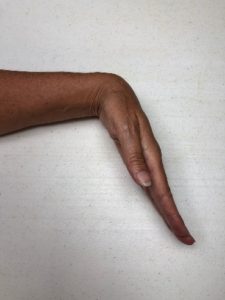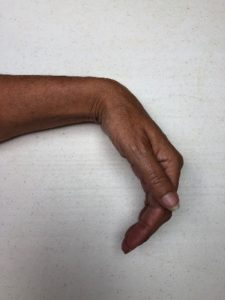An orthotist stated their patient has “mild tone, wrist flexed approximately to 80 degrees,” and asked what hand splint would be recommended.
Response: In this case, as with most hand splint choices, the thumb will determine the hand splint. If the thumb is severely adducted or there is thenar eminence collapse into the palm, you will need to remold a ThumbEase (with a heat gun) or a Universal Sized BendEase (bend by hand). The first preference would be a ThumbEase because the patient has tone, but if no one is available to remold this splint, then fit the Universal BendEase that has the same pocket of fabric under the thumb as the ThumbEase into which you can add more and more padding to begin to loosen up a severe thumb.
If the thumb has enough range of motion, you would choose the Restorative Hand (first choice) or the Sized BendEase (second choice) for the same reasons.
Whichever splint is fit, leave a good finger width between their wrist and the splint to allow the wrist to relax into the splint. Over time, as the patient improves, remold the wrist to continue the extension. You are relengthening tissue so be patient.
You will want to achieve a nice natural curve in the MCPs and all IP joints. That typically helps to extend the wrist and begins to form a more normal hand alignment.

The straight position shown above would not work the hand toward a normal functioning alignment and could potentially encourage hyperextending of the MCPs and IP joints.

This is the desired shape to mold a hand splint for a patient’s hand that has 80 degree wrist drop with tone – or with any finger extension to flex the MCPs, PIPs and DIPs. It should help to relax the increased muscle tone – and, also to encourage the wrist to begin to move toward extension. With good therapy, this hand can hopefully begin to regain at least some function. At the very least we are working toward a normal, more comfortable alignment and maintaining it there to prevent deformity.
When you remove the hand splint, you can stretch the fingers to full extension, if comfortable, to help to maintain full range.
Because this patient has “mild tone,” you will want to check from the spine and move toward the extremities. Typically, the etiology of increased tone or the lack of muscle tone (flaccidity) begins with the brain or spinal cord, so checking the posture of the spine and range of the shoulder and elbow is essential. As always, email me at karen.bonn@restorativemedical.com about a single patient, or restorative patients in general.
You can reach our customer service at 800-793-5544.
Thank you for using our Restorative Medical Flex Technology to help you and your patients to be successful.
